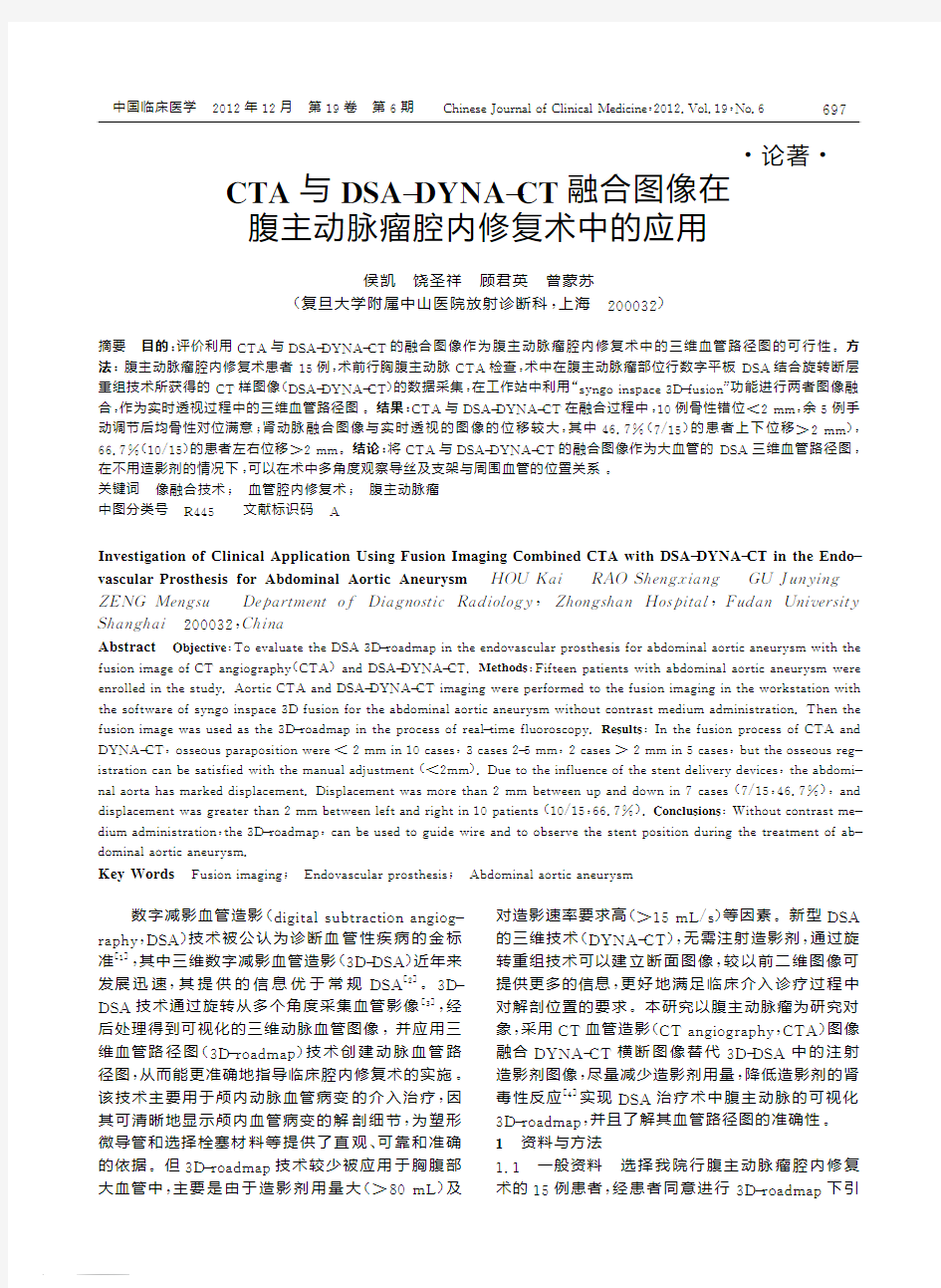CT融合图像在腹主动脉瘤腔内修复术中的应用

- 1、下载文档前请自行甄别文档内容的完整性,平台不提供额外的编辑、内容补充、找答案等附加服务。
- 2、"仅部分预览"的文档,不可在线预览部分如存在完整性等问题,可反馈申请退款(可完整预览的文档不适用该条件!)。
- 3、如文档侵犯您的权益,请联系客服反馈,我们会尽快为您处理(人工客服工作时间:9:00-18:30)。
中国临床医学 2012年12月 第19卷 第6期 Chinese Journal of Clinical Medicine,2012.Vol.19,No.6
·论著· CTA与DSA-DYNA-CT融合图像在
腹主动脉瘤腔内修复术中的应用
侯凯 饶圣祥 顾君英 曾蒙苏
(复旦大学附属中山医院放射诊断科,上海 200032)
摘要 目的:评价利用CTA与DSA-DYNA-CT的融合图像作为腹主动脉瘤腔内修复术中的三维血管路径图的可行性。方法:腹主动脉瘤腔内修复术患者15例,术前行胸腹主动脉CTA检查,术中在腹主动脉瘤部位行数字平板DSA结合旋转断层重组技术所获得的CT样图像(DSA-DYNA-CT)的数据采集,在工作站中利用“syngo inspace 3D-fusion”功能进行两者图像融合,作为实时透视过程中的三维血管路径图。结果:CTA与DSA-DYNA-CT在融合过程中,10例骨性错位<2 mm,余5例手动调节后均骨性对位满意;肾动脉融合图像与实时透视的图像的位移较大,其中46.7%(7/15)的患者上下位移>2 mm),66.7%(10/15)的患者左右位移>2 mm。结论:将CTA与DSA-DYNA-CT的融合图像作为大血管的DSA三维血管路径图,在不用造影剂的情况下,可以在术中多角度观察导丝及支架与周围血管的位置关系。
关键词 像融合技术; 血管腔内修复术; 腹主动脉瘤
中图分类号 R445 文献标识码 A
Investigation of Clinical Application Using Fusion Imaging Combined CTA with DSA-DYNA-CT in the Endo-vascular Prosthesis for Abdominal Aortic Aneurysm HOU Kai RAO Shengxiang GU Junying ZENG Mengsu Department of Diagnostic Radiology,Zhongshan Hospital,Fudan UniversityShanghai 200032,China
Abstract Objective:To evaluate the DSA3D-roadmap in the endovascular prosthesis for abdominal aortic aneurysm with thefusion image of CT angiography(CTA)and DSA-DYNA-CT.Methods:Fifteen patients with abdominal aortic aneurysm wereenrolled in the study.Aortic CTA and DSA-DYNA-CT imaging were performed to the fusion imaging in the workstation withthe software of syngo inspace 3D fusion for the abdominal aortic aneurysm without contrast medium administration.Then thefusion image was used as the 3D-roadmap in the process of real-time fluoroscopy.Results:In the fusion process of CTA andDYNA-CT,osseous paraposition were<2 mm in10 cases,3 cases 2-5 mm,2 cases>2 mm in5 cases,but the osseous reg-istration can be satisfied with the manual adjustment(<2mm).Due to the influence of the stent delivery devices,the abdomi-nal aorta has marked displacement.Displacement was more than 2 mm between up and down in 7 cases(7/15,46.7%),anddisplacement was greater than 2 mm between left and right in10 patients(10/15,66.7%).Conclusions:Without contrast me-dium administration,the 3D-roadmap,can be used to guide wire and to observe the stent position during the treatment of ab-dominal aortic aneurysm.
Key Words Fusion imaging; Endovascular prosthesis; Abdominal aortic aneurysm
数字减影血管造影(digital subtraction angiog-raphy,DSA)技术被公认为诊断血管性疾病的金标准[1],其中三维数字减影血管造影(3D-DSA)近年来发展迅速,其提供的信息优于常规DSA[2]。3D-DSA技术通过旋转从多个角度采集血管影像[3],经后处理得到可视化的三维动脉血管图像,并应用三维血管路径图(3D-roadmap)技术创建动脉血管路径图,从而能更准确地指导临床腔内修复术的实施。该技术主要用于颅内动脉血管病变的介入治疗,因其可清晰地显示颅内血管病变的解剖细节,为塑形微导管和选择栓塞材料等提供了直观、可靠和准确的依据。但3D-roadmap技术较少被应用于胸腹部大血管中,主要是由于造影剂用量大(>80 mL)及对造影速率要求高(>15 mL/s)等因素。新型DSA的三维技术(DYNA-CT),无需注射造影剂,通过旋转重组技术可以建立断面图像,较以前二维图像可提供更多的信息,更好地满足临床介入诊疗过程中对解剖位置的要求。本研究以腹主动脉瘤为研究对象,采用CT血管造影(CT angiography,CTA)图像融合DYNA-CT横断图像替代3D-DSA中的注射造影剂图像,尽量减少造影剂用量,降低造影剂的肾毒性反应[4]实现DSA治疗术中腹主动脉的可视化3D-roadmap,并且了解其血管路径图的准确性。
1 资料与方法
1.1 一般资料 选择我院行腹主动脉瘤腔内修复术的15例患者,经患者同意进行3D-roadmap下引
7
9
6
